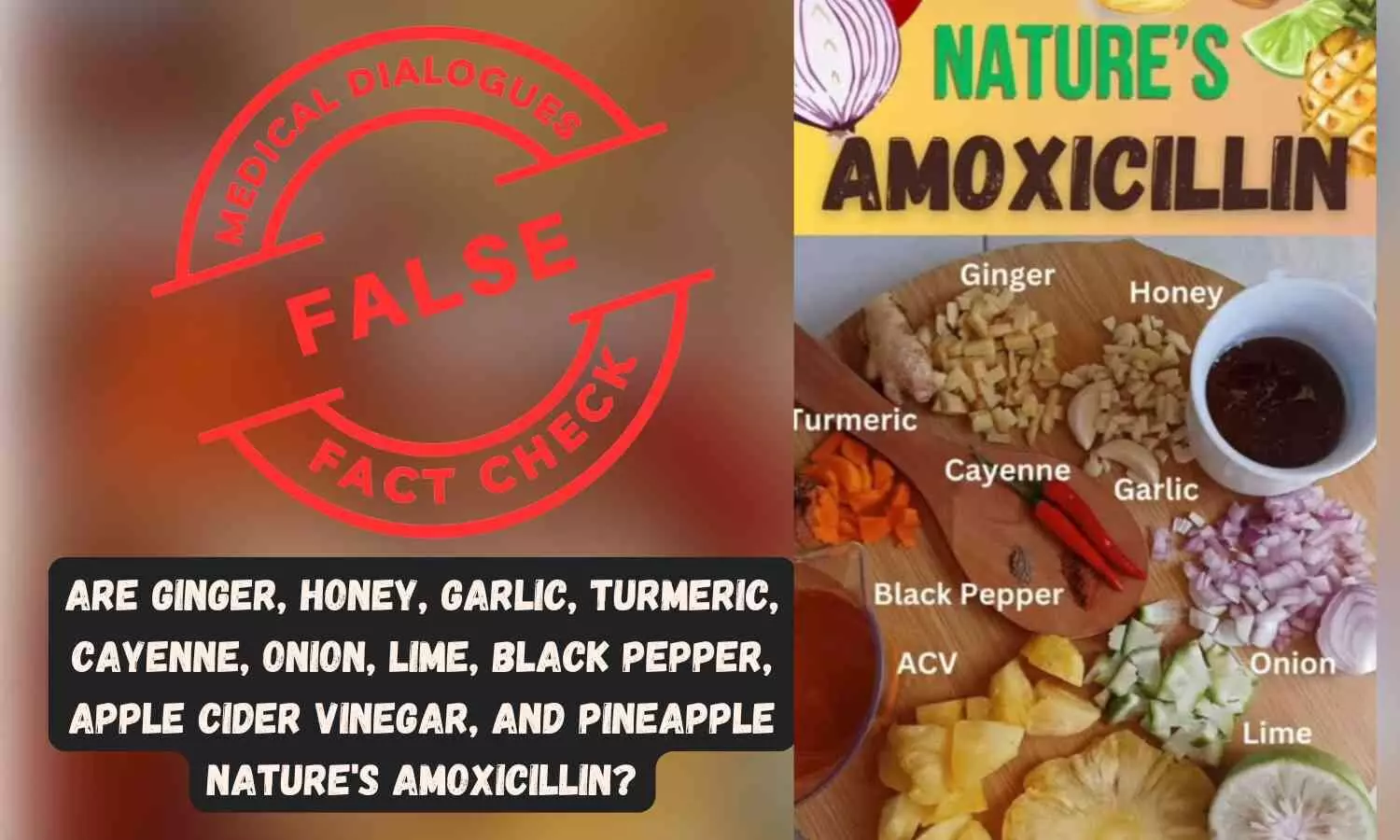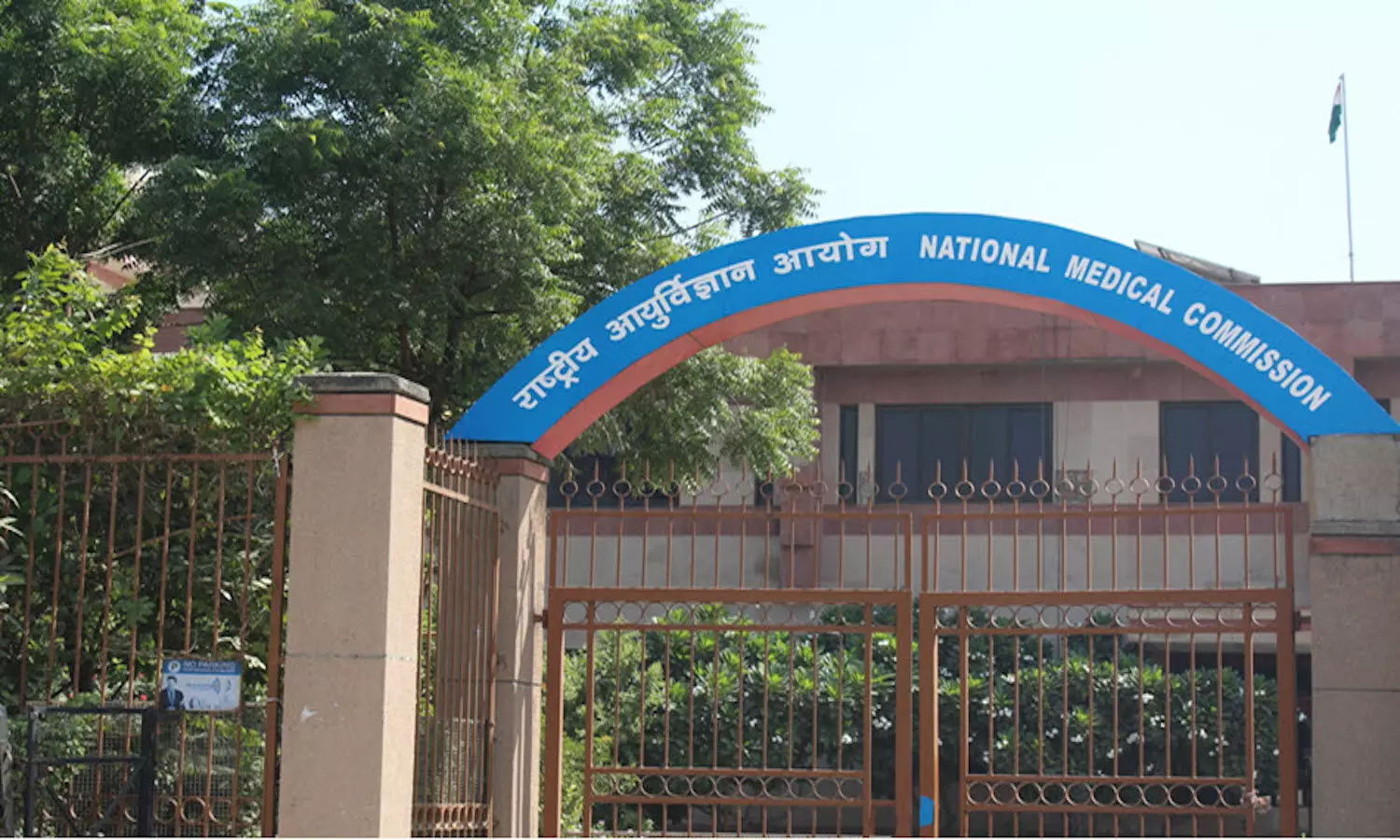Survey finds a dangerous gap in knowledge about pancreatic cancer among adults under age 50
Powered by WPeMatico
Powered by WPeMatico
Powered by WPeMatico
Powered by WPeMatico
Powered by WPeMatico
Powered by WPeMatico

A Pinterest post claims that ginger, honey, garlic, turmeric, cayenne, onion, lime, black pepper, apple cider vinegar, and pineapple are Nature’s amoxicillin. This claim is False.
In a Pinterest post, it is claimed that ginger, honey, garlic, turmeric, cayenne, onion, lime, black pepper, apple cider vinegar, and pineapple are Nature’s amoxicillin. In the post by Lacee Herbert, the user writes that ginger, honey, garlic, turmeric, cayenne, onion, lime, black pepper, apple cider vinegar, and pineapple are Nature’s amoxicillin. The post can be accessed here.
This user’s claim is FALSE. Ginger, Garlic, Honey, Turmeric and Black pepper possess certain antibacterial properties, but these ingredients cannot be portrayed as Nature’s amoxicillin that gives the impression that they serve the same purpose as antibiotic amoxicillin and/or have the same potency and purpose which is not true. Moreover, While these ingredients contain certain antibacterial properties other ingredients like cayenne, onion, apple cider vinegar and lime do not possess any antibacterial properties as is implied by the post.
Amoxicillin, a penicillin derivative, is an antibiotic targeting gram-positive bacteria, notably streptococcal strains that cause upper respiratory tract infections. It is rapidly and efficiently absorbed from the gastrointestinal tract, with a bioavailability of about 70% when taken orally. The drug reaches peak plasma concentration within 1-2 hours after oral administration. It treats different types of bacterial infections of the throat, lungs, ears, nose, urinary tract, and skin. Amoxycillin is also used with other medications to stop the growth of Helicobacter pylori bacteria that cause stomach ulcers.
Garlic (Allium sativum) a common culinary condiment, has long been used in traditional plant-based medicine, primarily due to its organosulfur compounds. These compounds have demonstrated significant biological and therapeutic properties, with their effectiveness depending on the method of preparation, use, and extraction. Garlic is known for its antioxidant, anti-inflammatory, and immunomodulatory effects, which help maintain immune system balance by positively influencing immune cells and modulating cytokine proliferation and expression. These properties suggest its potential in treating infections and tumors. Additionally, garlic’s organosulfur compounds offer vascular benefits, such as lipid metabolism regulation and antihypertensive and antiaggregant effects.
Ginger (Zingiber officinale) has long been valued as a medicinal herb due to its health benefits. The bioactive compounds in ginger are known for their antioxidant and anti-inflammatory properties, which can help modulate the immune system additionally, ginger aids in muscle relaxation. It is also recognized for its antioxidant benefits.
Apple Cider Vinegar (ACV), or cider vinegar, is derived from fermented juice from crushed apples, resulting in a pale to medium amber liquid. ACV retains some nutrients in apples, including pectin, B vitamins (B1, B2, B6), biotin, folic acid, niacin, pantothenic acid, and vitamin C. Research suggests that ACV may offer several health benefits, particularly for individuals with diabetes, as it has been shown to significantly reduce hemoglobin A1C (HbA1C) levels, lower low-density lipoprotein (LDL) cholesterol, and triglycerides while increasing high-density lipoprotein (HDL) cholesterol. ACV has been linked to decreased triglycerides and very low-density lipoprotein (VLDL) cholesterol. Nutrient-rich, especially in unfiltered and organic forms, ACV contains acetic acid, pectin, potassium, and calcium, which contribute to its potential health benefits. These include helping to regulate blood sugar levels, promoting weight loss, improving cardiovascular health, balancing body pH, and aiding in detoxification.
Pineapple is an important source of sugars, organic acids, essential minerals, vitamins, and fiber, contributing significantly to human nutrition. The fruit is also packed with health-boosting antioxidants, such as ascorbic acid, flavonoids, and carotenoids. The chemical composition of pineapple—including sugars, organic acids, minerals, fiber, aromatic compounds, vitamins, amino acids, flavonoids, and carotenoids—varies considerably by variety. Fresh pineapple contains small but noteworthy amounts of vitamin A and flavonoid pigments like β-carotene, xanthin, lutein, and β-cryptoxanthin, all of which contribute to antioxidant activity and support vision. A ripe pineapple can provide approximately 16.2% of the daily recommended intake of vitamin C. Pineapple is also among the few fruits abundant in the B-complex group of vitamins.
Honey is a natural product formed from the nectar of flowers by honeybees. It is consumed both for its nutritional aims and for its medicinal properties. Evidence indicates that honey may have several health-beneficial effects, including antioxidant, anti-inflammatory, antibacterial, antidiabetic, respiratory, gastrointestinal, cardiovascular, and nervous system protective effects.
Turmeric (Curcuma longa), commonly known as haldi, is widely used in Indian households, mainly as a spice. This plant, which belongs to the ginger family, is native to Southeast Asia and is primarily cultivated in that region, especially in India. Historically, turmeric has been utilized in Ayurveda and other traditional Indian medicinal practices, as well as in Eastern Asian systems like traditional Chinese medicine. In India, it was traditionally used for disorders of the skin, upper respiratory tract, joints, and digestive system. Turmeric is also one of the major sources of curcumin which is also responsible for turmeric’s distinctive yellow colour. Curcumin has received worldwide attention for its multiple health benefits, which appear primarily through its anti-oxidant and anti-inflammatory mechanisms. Research suggests that curcumin can help manage oxidative and inflammatory conditions, metabolic syndrome, arthritis, anxiety, and hyperlipidemia.
Black pepper is part of the Piperaceae family, which consists of more than 1,000 species commonly found in tropical and subtropical regions. Its active compound is piperine, and it also contains volatile oils, oleoresins, and a variety of alkaloids. The primary alkaloids in black pepper include piperine, chavicine, piperidine, and piperetine. Black pepper possesses antioxidant, anti-inflammatory, and antimicrobial properties, and it may also help prevent or alleviate gastrointestinal issues. By increasing the production of hydrochloric acid in the stomach, black pepper aids digestion by stimulating histamine H2 receptors. Additionally, it has diaphoretic effects, encouraging sweating, and diuretic properties, promoting urination.
Cayenne peppers act as natural blood thinners, thanks to their salicylate content. The capsaicin in cayenne supports smooth blood flow and may reduce the risk of blood clots. Additionally, it can help clear artery-narrowing lipid deposits, potentially dilating arteries and blood vessels, thereby alleviating clots and associated pain.
Onions add abundant flavor to a wide variety of food, yet are low in calories. With only 45 calories per serving, onions are naturally fat and cholesterol-free. They are a source of dietary fiber, vitamin C, vitamin B6, potassium, and other key nutrients including folate, calcium and iron. Onions contain a variety of other naturally occurring chemicals known as organosulfur compounds linked to lowering blood pressure and cholesterol levels. Among some of their best-known benefits, onions contain the flavonoid quercetin which acts as an anti-inflammatory in the body, inhibits low-density lipoprotein oxidation (an important reaction in atherosclerosis and coronary heart disease), protects and regenerates vitamin E (a powerful antioxidant), and protects from many forms of cancer.
Lime, a citrus fruit, is highly acidic and packed with vitamin C, citric acid, sugars, and essential minerals like calcium and phosphorus. Lime is also beneficial for digestive health, aiding in the treatment of indigestion, constipation, and peptic ulcers.
Ginger, honey, garlic, turmeric, and black pepper have antibacterial, anti-inflammatory, and immune-boosting properties, while cayenne, onion, lime, and apple cider vinegar lack notable antibacterial effects. Ginger, honey, garlic, turmeric, and black pepper possess antibacterial properties but cannot be termed as nature’s amoxicillin. Amoxicillin is a penicillin-class antibiotic prescribed for bacterial infections, while the ingredients can support general health but lack the efficacy and reliability of pharmaceutical antibiotics in treating infections. There is no scientific evidence that shows that Ginger, honey, garlic, turmeric, and black pepper provide the same antibacterial, anti-inflammatory effect as amoxicillin.
Bobak J. Akhavan et. al. noted that amoxicillin, a commonly used beta-lactam antibiotic, is approved by the U.S. Food and Drug Administration (FDA) for primary care use. It belongs to the aminopenicillin class, enhanced with an additional amino group to combat antibiotic resistance. Amoxicillin is indicated for treating infections caused by susceptible, beta-lactamase–negative bacteria, including ear, nose, and throat infections, eradication of Helicobacter pylori, lower respiratory and urinary tract infections, acute bacterial sinusitis, and skin and soft tissue infections.
Many of these natural food items contain antimicrobial properties as per research
The findings of a study published in Food and Chemical Toxicology indicate that ginger and its isolated compounds exhibit several key pharmacological effects, including immunomodulatory, antioxidant, antibacterial, anti-inflammatory, anti-apoptotic, anti-hyperglycemic, anti-lipidemic, and anti-emetic properties. Additionally, ginger is recognized as a potent antioxidant, which can help reduce or prevent the formation of free radicals. It is valued for its role in antibacterial properties.
A study by Manisha Deb Mandal et. al. found that honey’s healing properties are attributed to its antibacterial effects, ability to maintain a moist wound environment, and high viscosity, which creates a protective barrier against infection. The antimicrobial activity of most types of honey is primarily due to the enzymatic production of hydrogen peroxide. Honey is also praised for its ability to act as an antibacterial agent.
Serge Ankri et al. conducted a study revealing that allicin, a prominent compound in garlic, possesses extensive antimicrobial and antibacterial properties. Allicin is effective against both Gram-positive and Gram-negative bacteria, has antifungal properties, and demonstrates antiparasitic action against intestinal protozoa. It also possesses antiviral capabilities. The main antimicrobial mechanism of allicin involves its interaction with thiol groups in various enzymes. It is also admired for its effectiveness against bacteria as it possesses certain antibacterial properties.
In a study conducted by Bharat B. Aggarwal et. al., it was observed that curcumin, a compound in turmeric, possesses antioxidant, anti-inflammatory, antiviral, antibacterial, and antifungal properties. These effects are achieved by regulating transcription factors, growth factors, inflammatory cytokines, protein kinases, and other enzymes. It is well-regarded for its antimicrobial potential
A systematic review by Heerasing Takooree et. al. found that black pepper (Piper nigrum), abundant in bioactive compounds such as piperine, has demonstrated antibacterial, antimicrobial, antioxidant, antidiabetic, and hypolipidemic effects. Research indicates its potential in combating infections and reducing oxidative stress. Black pepper also exhibits anti-inflammatory, analgesic, and neuroprotective properties.
While ginger, honey, garlic, turmeric, and black pepper have recognized antibacterial properties, cayenne, lime, onion, apple cider vinegar, and pineapple as mentioned in the post lack evidence of such effects as can be given by the antibiotic amoxicillin. Also, there is no scientific evidence or medical consensus to support the claim that these natural ingredients have the same effect or potency or purpose as antibiotic amoxicillin and hence can be termed as nature’s amoxicillin.

Responding to the claim Dr. Juhi Singla, MD (Pharmacologist), SGT UNIVERSITY Gurgaon MBBS, Era’s Lucknow Medical College said, “Amoxicillin is a penicillin-based antibiotic commonly prescribed to treat various bacterial infections, including respiratory infections, ear infections, sinusitis, skin infections, and certain urinary tract infections. It works by interfering with the bacteria’s cell wall formation, leading to the destruction of the bacteria. While ingredients like ginger, honey, garlic, turmeric, cayenne, onion, lime, black pepper, apple cider vinegar, and pineapple have potential health benefits—such as boosting immunity and reducing inflammation—they cannot be natural amoxicillin. These natural remedies may support overall health but lack the antibiotic properties needed to combat specific bacterial infections. Relying solely on such natural remedies for treating bacterial infections can cause worsening of symptoms and delay necessary medical treatment, potentially leading to complications. Always seek proper treatment from doctors for accurate diagnosis and treatment.

Dr Sachin Choudhary, MBBS, MS (General Surgery), Army College of Medical Sciences further added, “Ginger, honey, garlic, turmeric, and black pepper exhibit some antibacterial properties, other ingredients like cayenne, onion, lime, apple cider vinegar, and pineapple do not. However, tagging these natural ingredients as nature’s amoxicillin’s is incorrect. While ingredients like ginger, honey, garlic, turmeric, and black pepper have some antibacterial properties, equating their effects to antibiotics like amoxicillin is not appropriate and should not be promoted. Amoxicillin is an effective, clinically tested antibiotic specifically designed to target and kill bacteria, ensuring complete eradication. Relying solely on natural remedies instead of prescribed antibiotics can lead to worsening infections and complications. Always consult a doctor for appropriate diagnosis and treatment of the disease.”
Ginger, honey, garlic, turmeric, and black pepper have been recognized for certain antibacterial properties, while cayenne, lime, onion, apple cider vinegar, and pineapple lack scientific evidence of similar effects. Additionally, there is no scientific evidence or medical consensus to support the claim that ginger, honey, garlic, turmeric, cayenne, onion, lime, black pepper, apple cider vinegar, and pineapple have effect as amoxicillin, a penicillin-class antibiotic, is prescribed specifically for bacterial infections.
Hence the claim made by the user is False.
Powered by WPeMatico

Madurai: With a motive to gain admission at the All India Institute of Medical Sciences (AIIMS) Madurai, a 22-year-old medical aspirant allegedly produced a fake NEET certificate following which he was arrested recently by the Kenikarai Police in Ramanathapuram district.
According to the police, the aspirant, a resident of Gangoti (PO) of Mandi district, Himachal Pradesh attempted for NEET twice but failed to pass the entrance examination for the last three years. Later, he managed to score only 60 marks out of 700 in one of his attempts this year but didn’t want to disappoint his father and therefore, he created a fake scorecard with 689 marks.
The matter came to light when the aspirant took his father to the AIIMS campus and submitted the fake certificate during the counselling process on October 19 for admission to the first-year MBBS course. While verifying his scorecard on October 25, the management found it to be fake and informed the police about the alleged fraud.
Also read- Fake NEET 2020 scorecard Scam: MBBS aspirant arrested in Chennai
Based on the complaint filed by the management, the police registered a case against the aspirant under Sections 336 (2), 336 (3), 336 (4) of BNS and 73 and 74 of IT Act. He was arrested after the police confirmed that he had created a fake mark sheet through a thorough investigation of his cell phone and e-mail details
As per DT NEXT news report, the police investigation revealed that the candidate intentionally performed poorly in his NEET examination to manipulate and create a fraudulent scorecard to secure admission to the premier institute.
A press release issued by the Ramanathapuram District Police as reported by ETV Bharat said “A complaint was received from the management of AIIMS Medical College under Kenikarai police station limits in Ramanathapuram district that a suspicious person had come to AIIMS with NEET score list for college admission.”
“This year he wrote the NEET exam again and got only 60 marks out of 720 marks, but with the aim of getting admission to the AIIMS Medical College, he edited the mark sheet from the NEET examination centre and prepared a fake mark sheet and deceived his family,” added the press release.
Meanwhile, CP Ganesh Babu, Faculty (in-charge), Academics and Administration, AIIMS, Madurai told DT Next, “Usually an offer letter or admission letter is downloadable, but the letter showed his personal email account. Moreover, the scorecard was found to have an unusual signature of the student. Normally, a NEET scorecard won’t have the signature of a student.”
Powered by WPeMatico

New Delhi: The Postgraduate Medical Education Board (PGMEB) of the National Medical Commission (NMC) has extended the deadline for submitting the Annual Declaration Reports for postgraduate medical courses.
Medical Colleges or institutes running PG medical courses have been directed by the Apex Medical Commission to submit the said report along with a fee of Rs 50,000 plus 18% GST for each PG medical course on the designated NMC portal by 15.11.2024.
NMC extended the deadline after receiving requests for extension of the last date of submission because of the festival month. While the Commission has extended the deadline from 31.10.2024 to 15.11.2024, it has also made it clear that no further extension would be provided.
Issuing a notice in this regard, the President of the PG Medical Board of NMC, Dr. Vijay Oza mentioned in the notice, “Post Graduate Medical Education Board(PGMEB) vide Public Notice of even number dated 01.10.2024 had directed all the Medical Colleges/ Institutes running PG Medical Courses to submit the Annual Declaration Report along with the requisite fee of Rs. 50,000/- plus 18% GST for each PG Medical Course being conducted by them, on the designated NMC’s portal by 31.10.2024.”
“A number of requests have been received in this Board for extension of last date of submission of the Report on the online portal due to the festival month. Accordingly, this Board has decided to extend the last date of submission of Annual declaration Report from 31.10.2024 to 15.11.2024 and no further extension will be provided,” the notice issued by the Commission further mentioned.
It added that “The other terms and conditions mentioned in the aforesaid Public Notice dated 01.10.2024 shall remain the same.”
Medical Dialogues had earlier reported that previously while asking the medical colleges/institutes running PG medical courses to submit an Annual Disclosure Report for the PG Medical Courses, NMC had specified that this two-part Annual Declaration Report would consist of Standard Assessment Form Part-A, which is the Institutional Informati9on Common for all PG Specialties and the Standard Assessment Form Part-B for Broad/Super Specialty courses.
“After its establishment, the medical college or medical institution is obligated to furnish an Annual Disclosure Report to the corresponding Board, satisfying such conditions provided under the notified MSRs by UGMEB or PGMEB and regulations of NMC, as the case may be,” NMC had mentioned in the notice dated 01.10.2024.
To view the order, click on the link below:
Powered by WPeMatico

Kakinada: Lyfius Pharma, a wholly owned step-down subsidiary of Aurobindo Pharma has announced the inauguration of its state-of-the-art PenG manufacturing facility, at Kakinada, Andhra Pradesh. With an annual production capacity of 15,000 metric
tonnes (MT), the facility was virtually inaugurated by Hon’ble Prime Minister Shri. Narendra Modi in the
presence of Jagat Prakash Nadda (Union Minister of Chemicals & Fertilizers, Health & Family Welfare),
Dr. Mansukh Mandaviya (Union Minister of Labour & Employment, Youth Affairs & Sports), Smt. Anupriya
Patel (Union MoS Chemicals & Fertilizers, Health & Family Welfare), Shri. Prataprao Jadhav (Union MoS (IC)
Ayush, MoS Health & Family Welfare) and Sushri Shobha Karandlaje (Union MoS Labour & Employment,
Micro, Small & Medium Enterprises).
Lyfius Pharma is engaged in the manufacturing of Penicillin-G. Its state-of-art facility is situated at Kakinada, Andhra Pradesh, approved under the PLI (Production Linked Incentive) scheme.
Read also: Aurobindo Pharma to acquire balance 49 percent stake in GLS Pharma for Rs 22.5 crores
Powered by WPeMatico

Madhya Pradesh- The Director of Medical Education (DME), Madhya Pradesh has released the timetable for the MP State Combined National Eligibility and Entrance Test-Undergraduate (NEET UG) Stray Vacancy Round Counselling for the academic year 2024.
As per the timetable, the MP State Combined NEET UG Stray Vacancy Round Counselling 2024 will begin today i.e., October 30, 2024, and end on November 05, 2024.
Below is the detailed timetable-
TIME TABLE
|
S.NO |
EVENTS |
DURATION |
NO. OF DAYS |
|
1 |
Publication of Remaining Vacancies and list of eligible candidates. |
30 October 2024 |
1 Day |
|
2 |
lnvitation of online application (choice-filling) by the eligible candidate on the portal against vacancies. Real-time College wise merit list of applicants L0 times the number of college vacancies on the portal. |
30 October 2024 to 02 November 2024 (06:00 PM) |
4 Days |
|
3 |
Reporting at Selected college by the candidate for Online Attendance. |
03 to 4 November 2024 (10:00 AM to 06:00 PM) |
2 Days |
|
4 |
Admission (selected candidate as per attendance merit), |
05 November 2024 (01:30 PM to 07:00 PM) |
1 Day |
Along with this MPDME has also released an advisory for the candidates participating in the (MBBS/BDS Courses) Stray Vacancy Round Counselling 2024.
ADVISORY
1 Eligibility – All such MP Online registered candidates who have not been allotted any seat in the first, second or mop-up phase.
2 Eligible candidates can submit their choice of college through the choice filling link available in their candidate login within the time period mentioned in the timetable. Candidates will be able to submit choice filling against vacant seats in more than one available college.
3. Real-time Choice filling/Attendance-based Merit of the applied candidates will be available on the college-wise portal.
4. As per the real-time merit of various colleges, the candidate who wishes to take admission to a college will have to appear in person at that institution within the time limit mentioned in the timetable and register his attendance through the Online attendance module.
5. After the attendance of the applied candidates, admission will be given to the eligible candidates based on attendance-based merit. On the date of admission, the candidates who are interested in admission and have logged online attendance against the seats available in a particular institute will have to be present in the institute before 01:00 PM. No claim of the candidate will be accepted after 01:00 PM.
6 For admission, it will be mandatory for the candidate to submit all the necessary original documents.
7 The prevailing scholarship schemes of the Government will remain applicable as per the rules.
8 Before admission, eligible candidates may deposit the institution fee in the college account by multicity cheque, DD or online mode.
9 After depositing the fee, the admit card of the candidate will be generated from the portal.
To view the timetable, click on the link below
To view the advisory, click on the link below
Powered by WPeMatico
